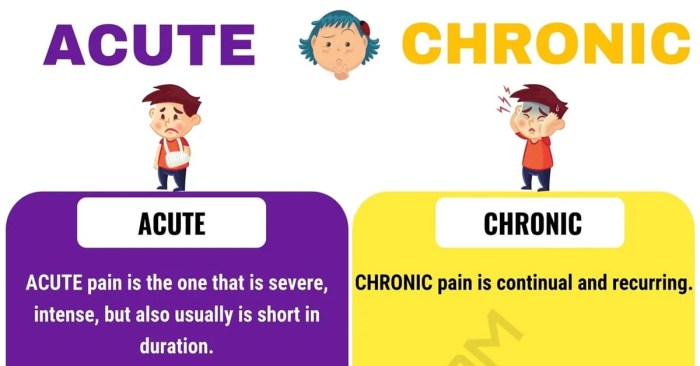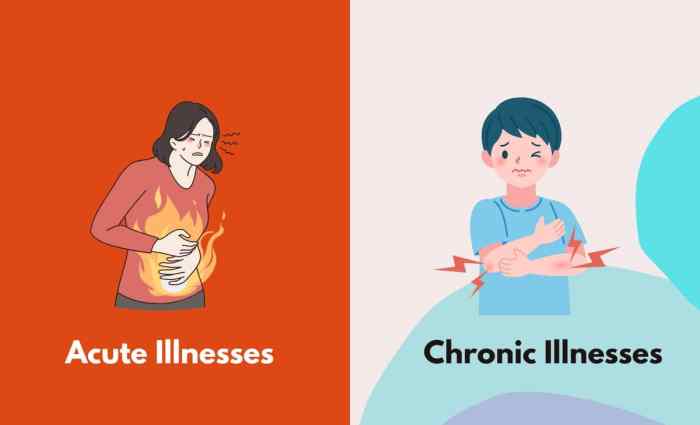Chapter 18 common chronic and acute conditions – Chapter 18: Common Chronic and Acute Conditions delves into the intricate world of health conditions that impact individuals worldwide. This chapter offers a comprehensive overview of both chronic and acute conditions, providing essential insights into their prevalence, impact, and management.
Chronic conditions, characterized by their long-term nature, are prevalent in our society. Examples include heart disease, diabetes, and arthritis. Acute conditions, on the other hand, are short-lived and often result from sudden events such as injuries or infections.
1. Common Chronic Conditions

Chronic conditions are health conditions that persist for a long period of time, typically three months or more. They are often complex and can impact a person’s daily life, work, and overall well-being.
Examples of common chronic conditions include:
- Heart disease
- Stroke
- Cancer
- Diabetes
- Arthritis
- Chronic kidney disease
- Chronic obstructive pulmonary disease (COPD)
Chronic conditions are prevalent worldwide, affecting millions of people. They can have a significant impact on individuals, families, and healthcare systems.
2. Acute Conditions

Acute conditions are health conditions that have a sudden onset and typically last for a short period of time, usually less than three months. They can range from minor ailments to serious illnesses.
Examples of common acute conditions include:
- Colds
- Flu
- Sprains
- Strains
- Infections
- Asthma attacks
- Appendicitis
Acute conditions can be caused by various factors, including viruses, bacteria, injuries, and allergies. Symptoms can vary depending on the condition.
3. Comparing Chronic and Acute Conditions
The following table compares chronic and acute conditions:
| Characteristic | Chronic Conditions | Acute Conditions |
|---|---|---|
| Duration | 3 months or more | Less than 3 months |
| Symptoms | Persistent, may vary in severity | Sudden onset, may be severe |
| Treatment | Ongoing management, may require multiple treatments | Short-term treatment, may resolve on its own |
| Prognosis | Can be managed, but may not be curable | Often curable, may have long-term effects |
4. Management of Chronic Conditions

Managing chronic conditions requires a comprehensive approach that involves medical care, lifestyle modifications, and self-management. Treatment plans are tailored to the individual’s specific condition and needs.
Different types of treatments for chronic conditions include:
- Medications
- Surgery
- Physical therapy
- Occupational therapy
- Dietary changes
- Exercise
Lifestyle modifications play a crucial role in managing chronic conditions. These may include:
- Maintaining a healthy weight
- Eating a balanced diet
- Getting regular exercise
- Managing stress
- Getting enough sleep
5. Management of Acute Conditions: Chapter 18 Common Chronic And Acute Conditions

Managing acute conditions typically involves addressing the underlying cause and providing symptomatic relief. Treatment plans vary depending on the specific condition.
Different types of treatments for acute conditions include:
- Medications
- Surgery
- Rest
- Physical therapy
- First-aid measures
First-aid measures are immediate actions taken to provide care for acute conditions before professional medical help arrives. These may include:
- Stopping bleeding
- Applying ice to reduce swelling
- Performing CPR
- Administering epinephrine for allergic reactions
General Inquiries
What is the difference between a chronic and an acute condition?
Chronic conditions are long-term health issues that persist for months or years, while acute conditions are short-lived and typically resolve within a few days or weeks.
What are some common examples of chronic conditions?
Common chronic conditions include heart disease, diabetes, asthma, and arthritis.
What are the principles of managing chronic conditions?
Managing chronic conditions involves a holistic approach that includes medication, lifestyle modifications, and regular monitoring to prevent complications and maintain quality of life.